NEW! Interactive planning-Order and disorder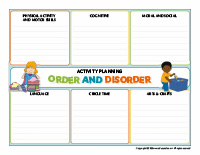
(Open interactive planning-Order and disorder) Print and use the document to present activities related to the theme for your group.
CIRCLE TIME
Children learn while having fun. For circle time, change up children's usual spots. If you use a different color to identify each child’s spot, mix up the colors throughout the theme. Change their places for lunch and naptime too. Scramble your words when you are speaking to your group (example: Hungry you are? Time lunch for now!). Ask children to help you unscramble your words.
NEW! 3D discussion-Order and disorder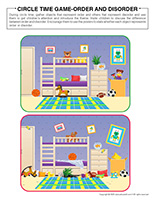
During circle time, gather objects that represent order and others that represent disorder and use them to get children’s attention and introduce the theme. (Open circle time game-Order and disorder) Invite children to discuss the difference between order and disorder. Encourage them to use the posters to state whether each object represents order or disorder.
NEW! Puppets-Order and disorder
(Open puppets-Order and disorder) Use the puppets for their "creative" aspect. Children will enjoy making them talk and interact. You will find several puppet models in the Educatall Club.
AREA SETUP
NEW! Thematic poster-Order and disorder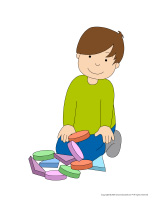
(Open thematic poster-Order and disorder) Print, laminate, and display the poster where parents are sure to see it.
NEW! Educa-theme-Order and disorder
(Open educa-theme-Order and disorder) Print and laminate the different elements representing the theme. The items can be used to present the theme to children (and their parents) or simply to decorate your daycare for the theme.
NEW! Educa-decorate-Order and disorder
(Open educa-decorate-Order and disorder) Print, laminate, and cut out the items. Use them to decorate your daycare walls and set the mood for the theme.
NEW! Stickers-Order and disorder
(Open stickers-Order and disorder) Print the illustrations on adhesive paper and use them to create a collection of original stickers.
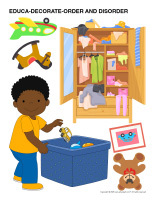
Let’s reorganize
Set sturdy cardboard boxes on the floor in your circle time area. Children will enjoy sitting on them during circle time. Cut several elongated triangles out of bubble wrap and Kraft paper. Hang them on a long string that you have hung much like a clothesline, alternating the two types of paper to create a pretty garland.
Getting things in order
Throughout the theme, pay attention to the way various items are stored in your daycare. Have fun moving things around and reorganizing items within your space. Use this theme to set aside any toys that are no longer used or broken. Provide brooms, vacuum cleaners, and dusting cloths.
STORAGE IDEAS
 Keep empty wipe boxes and use them to store scrap paper for crafts, puzzle pieces, etc. Stick a label on each box to identify its contents.
Keep empty wipe boxes and use them to store scrap paper for crafts, puzzle pieces, etc. Stick a label on each box to identify its contents.- Use shoeboxes to store small figurines. Wrap them with patterned adhesive paper.
- Collect egg cartons and use them in your craft corner. Pour glue or poster paint in the small sections; you can throw the cartons away at the end of the activity.
- Use a rolling storage bin in your craft corner. Store paper, cardboard, and pencils in it.
- Collect baby food jars, make holes in the lids, and use them to sprinkle glitter on children's artwork.
- Cut your empty cereal boxes diagonally and wrap them with pretty paper. They will be very useful for storing the many coloring pages that you print for your group.
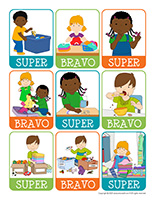 Use baskets or plastic bins that can be stacked one on top of the other to store food and dishes in your kitchen area.
Use baskets or plastic bins that can be stacked one on top of the other to store food and dishes in your kitchen area.- Use shoe bags to store children’s spare clothes.
- Install hooks labeled with children’s photos to store their personal items.
PICTURE GAME
NEW! The pictures may be used as a memory game or to spark a conversation with the group. This week, the picture game is related to various activities that are part of a regular day at daycare. You may display it for children and use the pictures to identify which activity will be next. This can help children feel safe and confident. (Open visual routine) Print, laminate, and store in a "Ziploc" bag or in your thematic bins.
WRITING AND ACTIVITY SHEETS
NEW! WRITING ACTIVITY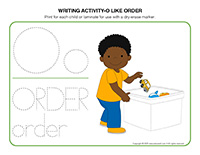
(Open writing activities-O like order) (Open writing activities-D like disorder) Print for each child or laminate for use with a dry-erase marker.
NEW! ACTIVITY SHEETS
(Open activity sheets-Order and disorder) Print and follow instructions.
NEW! Educa-spots-Order and disorder
(Open educa-spots-Order and disorder) Print for each child. Use bingo markers to add color inside the circles. If you don’t have bingo markers, simply invite children to set cereal or press stickers inside each circle.
NEW! PICTURE GAME-ORDER AND DISORDER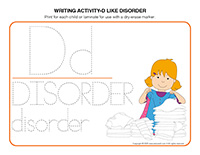
For this theme, the picture game we have created illustrates the different activities that make up your daily daycare routine. Ask children to arrange them in the correct order. You can display the pictures on a wall and use them to help children understand your schedule and what they will be doing next throughout the day. Arrival, circle time, free play, snack time, lunch, tooth brushing, naptime, playground outing, find your backpack, story time, library outing, outdoor play, workshops, swimming, say goodbye, walk, departure, group activities, discussion period, hand washing, getting dressed/undressed, bathroom use, diaper changes, task chart, clean up period. (Open picture game-Daily activities)
LANGUAGE ACTIVITIES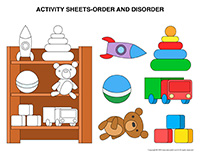
NEW! Word flashcards
The flashcards may be used to spark a conversation with your group, in your reading and writing area, or even to identify your thematic bins. (Open word flashcards-Order and disorder) or (Open giant word flashcards-Order and disorder) Print. Sort, put away, organize, order, plan, clean, disorder, draft, disorganized, mismatched, dirty, mess.
NEW! Educa-chatterbox-Order and disorder
(Open educa-chatterbox-Order and disorder) Print, laminate, and cut out the cards. Decorate a shoebox and set the cards as well as a variety of small items related to the theme inside it. During circle time or, for example, when children are waiting for lunch to be served, have them pick one card or item out of your chatterbox at a time and encourage them to name the item and tell you what they know about it.
Let’s unpack and put things away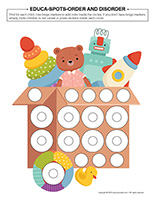
Here, you will have to have previously wrapped or painted 4 cardboard boxes that are the same size. Glue them together (2 on the bottom and 2 on the top) to represent a house with rooms. (Open rooms and objects to sort-Moving day). Print, laminate, and cut out the items. Use the labels to identify the rooms. Set all the objects in a cardboard box. Children take turns picking an object, naming it, and setting it in the appropriate room. They can, for example, say, “It’s shampoo. It belongs in the bathroom.” Certain objects can be associated with more than one room. Use them to foster conversation.
PHYSICAL ACTIVITY AND MOTOR SKILLS
NEW! Erasable games-Emotions-Order and disorder
(Open erasable games-Emotions-Order and disorder) Print and laminate. Let children pick a worksheet and use dry-erase markers to reproduce the emotion that is illustrated.
NEW! Modeling dough activity placemats-Order and disorder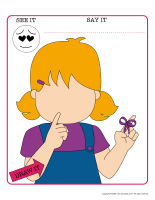
(Open modeling dough activity placemats-Order and disorder) Print and laminate. Let children pick a placemat and provide modeling dough. Encourage them to use the dough to fill or reproduce the shapes that are on their placemat.
NEW! Hunting for objects-Order and disorder
Show children an object that is in order and another that is in disorder. Then, encourage them to identify objects within your daycare that are in order and in disorder.
NEW! Order and disorder hop
(Open picture game-Order and disorder) Print. Laminate the pictures and press them on the floor using adhesive paper. Play music. When the music stops, children must quickly jump on a picture representing order or disorder (or both), depending on your instructions.
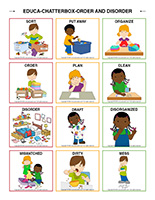
A place for everything
Before children arrive (or with the help of older children during naptime), press colorful electrical tape around different items that make up your daycare setup. You can, for example, press electrical tape on the floor, all the way around your play kitchen, your chairs, your table, your area rugs, your dollhouse, your toy car bin, etc. Next, set all the corresponding items in the center of your daycare. Invite children to return them to their correct spot, one by one, much like a life-sized puzzle. Use this activity to move certain items to a new area by tracing their contour elsewhere within your space. This will make this activity somewhat more difficult for older children who will have to observe the shape of the items closely to determine where they must go.
Reproducing a décor
Gather tiny furniture items and accessories that are normally used in your dollhouse. Arrange them in your dollhouse and photograph each room. Print the pictures. Next, set all the furniture items and accessories in a bin and invite children to reproduce the photographed décor.
Identifying your play areas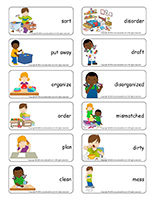
Photograph children when they are playing in your different play areas. The goal is to have several pictures representing each area. For example, for your manipulation area, you could have a picture of a child who is threading necklace beads on a string, a picture of a child who is assembling puzzle pieces, a picture of a child who is creating patterns with colorful buttons, etc. Print the pictures and press adhesive putty behind each one. During circle time encourage children to press each picture in the appropriate play area.
Pickup
Sit in a circle with your group. Hold a deck of cards in your hands. Ask children if they want to play a game of pickup. At the same time, throw the deck of cards up in the air. Children pick up the cards. When they are done, have them sort the cards by color or kind: hearts, diamonds, spades, clubs.
The storm
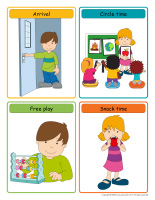 Create a toy storm. Gather as many toys as possible and deposit them in the center of your daycare. When you give them the signal, children must put each object where it belongs before the storm blows everything away. Use a vacuum cleaner to represent stormy sounds.
Create a toy storm. Gather as many toys as possible and deposit them in the center of your daycare. When you give them the signal, children must put each object where it belongs before the storm blows everything away. Use a vacuum cleaner to represent stormy sounds.
I am cleaning up with my feet
Deposit tiny objects such as blocks, buttons, pompoms, crayons, small figurines, etc. on the floor. Have children sit in a circle and remove their socks. The object of the game is to pick up as many objects as possible using their toes and drop them into an empty container.
Sorting everything
Have fun sorting objects per their shape, size, color, material, etc. Deposit several boxes throughout the daycare and glue illustrations on them to help children associate objects to the correct category.
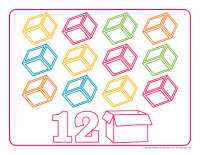
Upside down world
Divide your group into two teams. The first team leaves the room. The other team changes five objects within the daycare. For example, they may put a cushion on the floor, change a clothing item on one of their team members, place an item upside down, etc. When the first team returns, they must find the five differences. Change teams and repeat.
Renovations
In your construction area, provide children with plastic containers, empty cardboard boxes, etc. They will enjoy building castles with the recycled material. You may also ask your local grocer for cardboard boxes. Let children play with the boxes, guided by their imagination. They will spend hours building tunnels, houses, towers, and structures of all kinds. When children tire from renovating, have them set the boxes in a corner of your daycare or invite them to use them to store toys until their next renovation session.
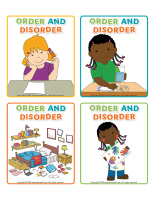
Tupperware cupboard
We all have a cupboard full of plastic containers. Let children play in it and make it as messy as they want before placing the containers back in an orderly fashion.
I am sorting pairs
Choose identical objects (for example: a pair of socks, 2 clothespins, 2 buttons, 2 mittens, 2 forks, 2 crayons, etc.). Put all the objects in a large box and ask children to find all the pairs. This is a simple way to teach children how to sort certain objects.
Jars and lids
Present children with an assortment of jars, approximately 6 to 8, of different sizes. The goal of this activity is to find the correct lid for each jar. This is excellent for stimulating classification abilities. For older children, add a jar and a lid that do not belong together. This makes the exercise more difficult. Children may also sort the jars from the smallest to the biggest.
COGNITIVE ACTIVITIES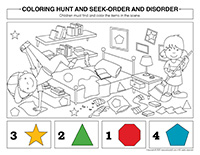
NEW! Coloring hunt and seek-Order and disorder
(Open coloring hunt and seek-Order and disorder) Print and laminate. Children must find and color the items.
NEW! Roll and color-Order and disorder
(Open roll and color-Order and disorder) Print for each child. This game can be enjoyed individually or as a group. Children roll a die, count the dots, and color the corresponding part of the drawing.
NEW! String activities-Order and disorder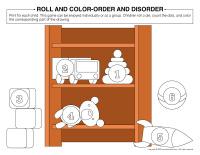
(Open string activities-Order and disorder) Print for each child. Children trace the lines using white glue and then press string in the glue to outline the shapes.
NEW! Educ-association-Order and disorder
(Open educ-association-Order and disorder) Print and laminate the items. Children must associate each item to the correct scene, observing whether they represent order or disorder.
NEW! Educ-reproduce-Order and disorder
(Open educ-reproduce-Order and disorder) Children pick a card, describe what they see, mentioning as many details as possible, and reproduce the scene representing order or disorder.
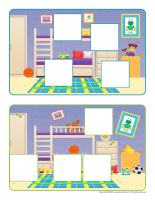
NEW! Educ-numerical puzzles-Order and disorder
(Open educ-numerical puzzles-Order and disorder) Print, laminate, and cut out the puzzle pieces for durable, eco-friendly use. Children must arrange the puzzle pieces in numerical order to recreate the scenes.
NEW! Decide what represents order best
(Open worksheet-what represents order best) Print a worksheet as well as the page with questions. Read each question. Have children observe the worksheet and respond.
NEW! Educ-pattern-Order and disorder
(Open educ-pattern-Order and disorder) Print and laminate the game. Children must determine the correct order and complete each pattern by pressing the appropriate cards in the squares using adhesive putty.
NEW! Big and small-Order and disorder
(Open big and small-Order and disorder) Print and laminate the game. Press Velcro or adhesive putty behind each card. Children must arrange identical items from smallest to biggest on the game board.
NEW! Counting cards-Order and disorder
(Open counting cards-Order and disorder) Print and laminate. Prepare a series of wooden clothespins on which you have painted or written numbers 1 to 9. Children count the items on each card and attach the clothespin that has the corresponding number on it.
NEW! Pick, search, and color letters-Order and disorder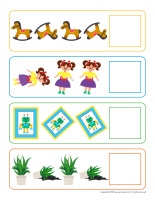
(Open pick search and color letters-Order and disorder) Print and laminate the letters. Children pick a card and search for and color the corresponding letter.
MORAL AND SOCIAL ACTIVITIES
Backwards day
(Open perpetual calendar-Backwards Day) Print for each child. Ask children to attend daycare with their clothes on backwards. Greet children with your clothes on backwards too. Greet them with, "Good evening my friend!" Scramble children's names. During circle time, sit back-to-back. Walk backwards when you move from one area to another. Throughout this special day, have children brush their teeth prior to eating. Why not begin lunch with dessert? Change children's places for naptime.
NEW! I keep my house tidy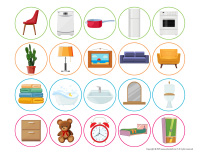
Have fun sorting objects per their shape, size, color, or material. Place different boxes in your daycare and press a picture on each one to help children associate each object with the correct category.
Upside down world
Divide your group into two teams. The first team leaves the room. The other team changes five objects within the daycare. For example, they may put a cushion on the floor, change a clothing item on one of their team members, set an item on a shelf so that it is upside down, etc. When the first team returns, they must find the five differences. Change teams and repeat.
Memory box in order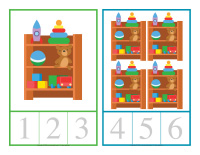
Invite children to introduce themselves to the group in a special way, by participating in a simple imaginary game. Give each child a small box. Encourage them to fill their box with items that would help others remember them if, for example, they moved away. They can take their box home and add photos, toys they particularly enjoy, something representing an activity they regularly take part in, etc. Each child presents their box to the group.
ARTS & CRAFTS
Order and sequence
Provide children with various arts & crafts materials (feathers, pasta, buttons, pieces of paper, stickers, etc.). Ask them to make a collage using a series of objects, arranging them from the smallest to the biggest.
Silly drawing
Blindfold children and invite them to draw themselves.
NEW! Puppets-Order and disorder
(Open puppets-Order and Disorder) Print the different puppet models on cardboard. Ask children to cut them out and decorate them with various materials. Attach the images to wooden sticks (like Popsicle sticks) to create puppets.
NEW! Models-Order and disorder
(Open models-Order and disorder) Print the different models as needed. Use them for various activities and creations throughout the theme.
COLORING PAGES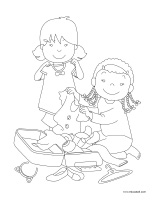
NEW! (Open coloring pages theme-Order and disorder) Print for each child.
SONGS & RHYMES
Order and disorder
by: Patricia Morrison - sung to: Twinkle, twinkle little star
Order, order, disorder
Upside down and inside out
Sorting and classifying
All things we must think about
For our daycare to be clean
We must keep it in order
Have fun!
The educatall team
 Home
Home Theme activities
Theme activities
 Babies and toddlers
Babies and toddlers
 Arts and crafts
Arts and crafts
 Science
Science
 Creative recipes
Creative recipes
 Tips and tricks
Tips and tricks
 Special needs
Special needs
 Extra activities
Extra activities
 Educ-TV
Educ-TV
 Newsletter
Newsletter  Online store
Online store Educatall club
Educatall club

